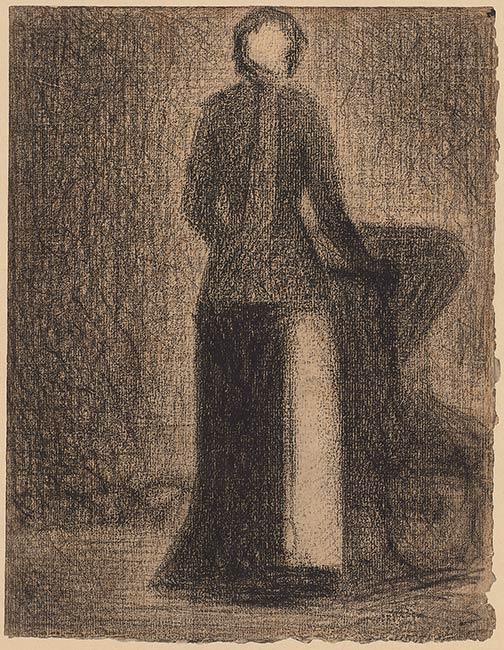

Between 1880 and 1884, Seurat created about four hundred drawings, in which he developed some of the major tenets of neo-impressionism. Rejecting the emphasis on line drawing that dominated his academic training at the École des beaux-Arts, he elaborated a technique based on contrast, in which forms are not defined by contour lines but by differences in tone and value with neighboring areas. In the present work, the figure stands out against the background through a series of light and dark contrasts. The lightening of the gray around her creates a kind of halo that would become typical of Seurat's art as he grew increasingly interested in the interactions between adjoining surfaces and especially in the optical phenomenon by which a light surface appears lighter against a dark background and vice versa.
Like most of Seurat's drawings, this sheet is remarkable for its velvety surface, lustrous black and rich palette of grays, achieved with the artist's favorite drawing medium, the Conté crayon. Greasier than pencil or charcoal, this crayon--named for its inventor, Nicolas-Jacques Conté (1755-1805)--allows for greater variations of value. When applied with light pressure, it leaves the white between the ridges of a heavy-textured paper untouched, creating beautiful grays by optical mix. Under heavy pressure, however, ti crushes the tufts of paper fiber and produces shiny black surfaces, such as can be seen in the nurse's skirt. This undated drawing has traditionally been related to Seurat's work of 1882 for its graphic approach characterized by a variety of crayon marks, including horizontal lines, diagonal hatching, and swirling strokes. Robert Herbert suggested the later date of circa 1884 because of the geometric regularity of the composition, which he associates with Seurat's studies for La Grande Jatte (Art Institute of Chicago; Herbert 1962, p. 118). Devoid of details, the scene is reduced to simple geometric patterns, in a process of distillation for which Seurat is often considered a precursor of twentieth-century abstract art.
The figure of the nurse, who appears frequently in Seurat's drawings (de Hauke 1961, 486-88 and 630) is recognizable by her bonnet with long ribbons in the back, the attribute of the Parisian wet nurse of the second half of the nineteenth century (the original title of this drawing was Le Bonnet à rubans, or "The Bonnet with Ribbons.") Wet nurses played a major role in Parisian social life of the time and were a common sight in the city's public parks. According to Fanny Faÿ-Sallois (1980, p. 244), "Like the elevator and electric light, the services of a living wet-nurse become a decisive element in bourgeois comfort, and a visible and flattering mark of wealth." Seurat was no doubt attracted to the geometric design and contrasting tones of their uniform, but there may also be a social dimension in his choice of the subject. These working-class women belong to the same category as the peasants, street vendors, laundresses, and other workers to whom Seurat was drawn. Inspired by the naturalist movement of the mid-nineteenth century, he expressed in his drawings his sympathy for ordinary men and women, whom he removed from the harsh realities of everyday life by endowing them with an aura of mystery and poetry.
Inscribed by Maximilien Luce in blue chalk, at left, "G. Seurat"; his own initial below, in blue chalk, "L"; numbered in red chalk, "317".
Watermark: illegible fragment.
Fénéon, Félix, 1861-1944, former owner.
Cousturier, Edward, former owner.
Cousturier, François, former owner.
Cousturier, Lucie, former owner.
Sair, Samuel, former owner.
Sair, Samuel, Mrs., former owner.
Thaw, Eugene Victor, former owner.
Thaw, Clare, former owner.
The Morgan Library & Museum, New York, NY, "Drawn to Greatness: Master Drawings from the Thaw Collection", 2017. Exh. cat., no. 358, repr.
Stampfle, Felice, and Cara D. Denison. Drawings from the Collection of Mr. and Mrs. Eugene V. Thaw. New York : Pierpont Morgan Library, 1975, no. 104, repr. (also in Thaw III, no. 91)
Denison, Cara D. et al. The Thaw Collection : Master Drawings and New Acquisitions. New York : Pierpont Morgan Library, 1994, no. 91, repr. (recto and verso).
De Hauke, César: Seurat et son œuvre. Paris, 1961, cat. no. 485.
Herbert, Robert L.: Seaurat's Drawings, New York, 1962, pp. 117-18, cat. nos. 99 and 170.
Georges Seurat, 1859-1891. New York: The Metropolitan Museum of Art, 1991, cat. no. 43.
Denison, Cara D. et al. From Mantegna to Picasso : Drawings from the Thaw Collection at the Pierpont Morgan Library, New York. London : Royal Academy of Arts ; New York : Pierpont Morgan Library, 1996, no. 88, repr.
Seurat and the Making of La Grande Jatte. Chricago: Art Institute of Chicago, 2004, cat. no. 34.
From Leonardo to Pollock: Master drawings from the Morgan Library. New York: Morgan Library, 2006, cat. no. 94, p. 196-197.
100 Master drawings from the Morgan Library & Museum. München : Hirmer, 2008, no. 93, repr. [Isabelle Dervaux]
